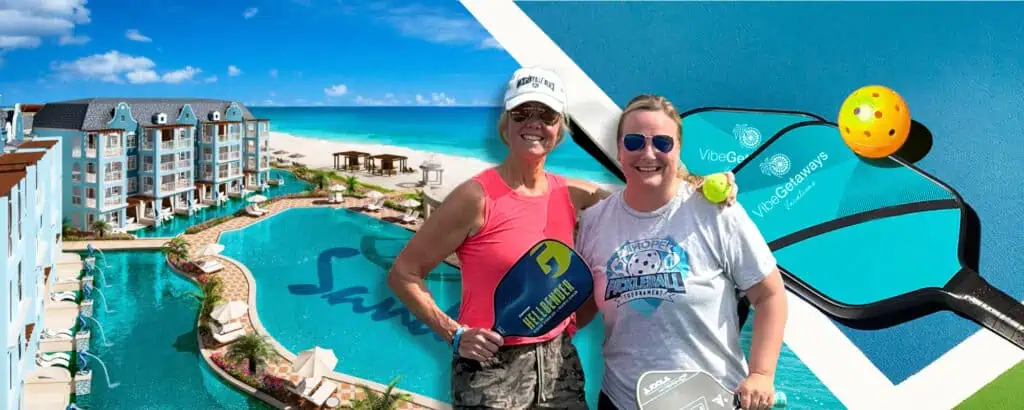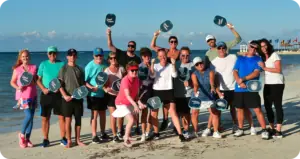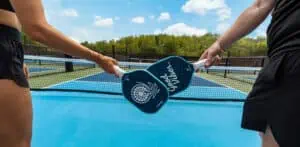Pickleball
Common Pickleball Mistakes and Strategies to Fix Them

Pickleball is more than just a fun pastime; it’s a fast-paced sport that offers an exciting combination of strategy, skill, and social interaction. Whether you’re picking up a paddle for the first time or returning to the game after a break, it’s easy to fall into certain traps that hamper your progress. Many players, regardless of their experience level, face similar issues on the court—like serving faults or poor footwork—that can turn a promising game into a frustrating experience. With some awareness and focused practice, you can identify these common mistakes and learn simple strategies to correct them. So let’s dive into the common pickleball pitfalls players encounter and how you can avoid them!
Common pickleball mistakes include missed serves, wild shots, and improper footwork. To fix these issues, players should prioritize accuracy with a “get it in” mentality during serves and returns, practice controlled hitting instead of attempting aggressive wild shots, and utilize “split step” footwork to improve positioning on the court.
Identifying Common Pickleball Mistakes
One common mistake that often trips up players, especially those who are just starting out, is hitting the ball out of bounds. While aiming close to the lines may seem like a smart strategy, it actually reduces your margin for error. More often than not, this aggressive play leads to frustrating faults. In fact, a recent survey noted that about 75% of players ranked between skill levels 3.0 and 3.5 confessed to regularly making this mistake.
Another issue that frequently arises is improper footwork.
Many players fall into the trap of remaining flat-footed or relying on long strides while moving around the court. This lack of agility not only restricts movement but can also delay responses to fast shots from opponents. To enhance mobility, think about employing small, quick shuffle steps instead; this technique can transform your positioning dramatically when dashing across the court.
| Common Mistake | Consequence | Fix |
| Hitting Out of Bounds | Loss of points | Aim inside the court’s safe zones |
| Flat-footed Stance | Decreased agility | Use small, quick shuffle steps |
| Incomplete Serves | Weak, easily returned serves | Follow through with a full arm swing |
| Neglecting the “Kitchen” | Missed strategic opportunities | Use strategically, avoid volleying |
It’s not just footwork that can lead to errors; another crucial aspect where players stumble is with their serves.
Serving inconsistently is another frequent pitfall that hinders performance. An incomplete serve results in weak shots, making them easy targets for your opponent. To rectify this issue, focus on following through with a full arm swing every time you serve; this adds power and precision to your game.
Understanding these common mistakes and focusing on specific strategies can hugely impact player skills. Regular practice addressing these elements will surely enhance enjoyment of the sport overall.
With a clear grasp of these prevalent mishaps, it’s essential now to refine one critical aspect of your game—the serve itself to ensure stronger performance.
Correcting Serve Errors
Serving in pickleball may appear simple, but achieving precision and power often eludes many players. A common issue among recreational players is the incomplete serve, which weakens both the shot’s direction and force. This error turns what should be an advantage into an opportunity for the opponent to capitalize on poorly executed shots. Thus, focusing on a complete follow-through is essential; think of your arm swinging through a large arc to maintain both power and direction.
To improve your serve, consider this: how often do you watch the pros? When observing elite players like Dekel Bar and Christian Alshon, you’ll notice that their serves are characterized by a full arm motion rather than a half-hearted flick. This vital technique creates momentum and stability in their shots. It’s not just about getting it over the net but ensuring it lands with intention, challenging your opponent from the very beginning.
As you engage in practice sessions with a partner or utilize wall drills, emphasize making contact with the ball at its highest point—this small adjustment can significantly enhance your accuracy and power.
Additionally, help players discover their serving positions—many struggle with positioning on the court, leading to inconsistent results. The ideal stance allows more room for movement and a natural posture for a fluid serve. Be mindful that when standing behind the baseline, your weight should shift as you strike the ball, preparing for immediate follow-up play.
Another strategy revolves around developing patience during practice. Rushing your serves often leads to errors—a missed opportunity that can disrupt your rhythm in a match. Try taking a moment to breathe, visualize where you want your serve to land, and then execute efficiently before returning to a ready position.
You might also consider focusing on your grip; using the correct grip influences both spin and control during your serve. Some players tend to overlook this aspect, resulting in chaotic shots that fall short of expectations. Experimenting with various grips can help you find what feels most comfortable and effective for you.
Improving your serve isn’t solely about physical drills; adopting a mindset that embraces change will go far toward mastering any skill. Mistakes are integral to development—acknowledge them, learn from them, and approach each session with the intent to grow stronger. Through committed practice and awareness of these techniques, every serve can become an asset rather than a liability.
With serving addressed, we’ll now transition into examining another pivotal element of gameplay—the essential techniques that can elevate your performance on the court.
Improving Forehand Techniques
The forehand in pickleball isn’t just another shot; it’s a crucial weapon in your arsenal. Its power can turn the tide of a match if executed expertly. Just think about a player like Hunter Johnson, whose forehand strikes fear into his opponents. What sets him apart? The secret lies in his optimal body rotation and precise point of contact. If you want to emulate that kind of effectiveness, it’s essential to refine your approach by mastering certain key components.
Steps to Improve Your Forehand
To enhance your forehand execution, begin with your stance. Positioning is vital; standing with your feet shoulder-width apart not only provides stability but also allows for proper weight transfer. This balanced stance gives you the foundation needed for effective movement and shot-making.
Next, let’s talk grip. The continental grip is preferred by many players for its versatility; it helps achieve both power and control. When held correctly, the paddle should feel snug yet mobile in your hands, allowing fluidity as your arm swings through the motion.
As you swing, focus on rotating your body rather than relying solely on your arm. This rotation engages the core muscles, enhancing power without unnecessary strain. Make sure to practice connecting with the ball slightly ahead of your body—a crucial aspect for maximizing velocity and accuracy.
Following through after making contact is equally important. Your paddle should finish high and be directed towards your intended target. A full follow-through not only encourages good habits but also improves shot consistency over time.
With these steps in mind, each element not only improves individual shots but also complements each other to create a comprehensive forehand strategy. Once these techniques are refined, attention can shift toward strategies that enhance positioning on the court.
Enhancing Court Positioning
Proper positioning is crucial in pickleball because it allows players to cover more ground efficiently and keeps them in control of the game. Many recreational players often make the mistake of standing too close to the baseline or the net, leading to missed opportunities and poorly executed shots. Incorrect positioning limits your ability to react to incoming balls and places undue pressure on your partner during doubles play.
Imagine a scenario where you’re playing a match with your partner. You’re both crowding the net, trying to make aggressive plays, but you miss critical volleys because you’re out of proper stance. By staying too close either to the baseline or the net, you find yourself scrambling for shots rather than setting up for strategic plays.
The Importance of the “Neutral Zone”
Central to effective court positioning is understanding the concept of the “Neutral Zone.” This area exists between the baseline and the non-volley zone (often referred to as the “kitchen”). Maintaining control over this zone gives you an advantage—allowing for both strong defense and offensive plays.
Positioned within this neutral area, you can respond more proactively to opponents’ shots while setting yourself up for your own attacks. It’s important to practice moving fluidly in and out of this zone during drills or matches, getting accustomed to finding your ideal stance based on ball placements.
Moving as a Unit in Doubles
When playing doubles, it’s imperative for partners to function as a cohesive unit. Utilizing small shuffles and maintaining a staggered stance will enhance your team’s coverage on the court. While one player might advance toward the net to apply pressure, the other should hover closer to the baseline, ready to intercept any deep shots.
Think about it like a dance—each partner must move in sync with one another, covering their own territory while being aware of each other’s movements. To practice this movement coordination, try setting up drills that encourage communication and shared decision-making regarding who should take what shot.
Effective communication becomes paramount here as it helps avoid overlaps while fostering teamwork within your strategy. Next, let’s explore how pivotal dialogue can enhance performance in doubles play.
Effective Communication in Doubles
The importance of communication in doubles cannot be understated. When players synchronize their intentions and reactions, they establish a rhythm that enhances teamwork and overall performance on the court. Imagine standing side by side with your partner during a competitive match. Each player’s quick call of “Mine!” or “Yours!” can dictate who takes the shot, simplifying potentially chaotic exchanges and avoiding collisions. In the heat of battle, split-second decisions often make the difference between winning or losing; thus, clear verbal and non-verbal cues become essential.
Many seasoned players advocate for vocalizing intentions as a standard practice. Using concise commands creates a more fluid game where both partners are aware of each other’s placement and actions. For example, if one player is preparing to intercept an incoming shot, promptly stating “I’ve got this!” minimizes uncertainty for the other player, allowing them to reposition without hesitation. Effective communication is particularly vital during fast-paced rallies where rapid adjustments must be made.
But just shouting out your intentions isn’t enough; there are strategies that elevate communication further.
Establishing a set of hand signals or code words before a match can streamline interactions, especially amid the noise of cheering spectators or other distractions. For instance, using specific gestures to indicate which type of shot you plan to play reminds both players of their roles without adding verbal clutter to the exchange. This method reduces confusion and maintains focus, keeping everyone aligned with the game plan.
Practicing these communication techniques during training sessions allows players to develop familiarity with each other’s styles while fostering confidence in calling out shots mid-game. Integrating regular ‘communication drills’ into your routine can involve practicing various scenarios where quick thinking and coordination are required, solidifying trust and reliability within the team.
While some might argue that excessive chatter could disrupt concentration or seem cumbersome, maintaining clarity with decisive communication aids in driving performance, enhancing both players’ comfort levels on the court. It simplifies complex situations into manageable calls—thus reducing chaos during critical moments.
By committing to honing communication skills, players create a resilient partnership that thrives under pressure and maintains strategic cohesion throughout each match. As we turn our attention forward, let’s explore practical approaches to enhance consistency and performance on the court.
General Tips for Consistent Gameplay
One of the pillars of achieving consistent gameplay is establishing good habits from the very beginning. The first recommendation is to always warm up properly. A mere 15 minutes dedicated to light exercises and practice shots can significantly enhance muscle readiness and mental focus. It’s like tuning a musical instrument before a concert; without that crucial step, even the most talented players might sound out of sync. By getting your body moving and honing those reflexes, you prime yourself for a better game.
After warming up, it’s vital to stay hydrated. Water acts as a critical fuel for your body during play. Dehydration can lead not only to fatigue but also compromise your reaction time. In fact, research shows that losing just 2% of your body weight can impair physical performance. Maintain your peak performance by regularly sipping water throughout your matches, especially during breaks.
Speaking of preparation, let’s talk about the equipment you choose.
Investing in quality gear cannot be understated. This brings us to our next key point: use reliable equipment. High-quality paddles designed specifically for pickleball will enhance your performance, providing you with better control and power on your shots. Similarly, good footwear is essential for comfort and balance on the court. If you’re going to genuinely commit to improving your game, “playing it safe” with inferior equipment isn’t an option; think of it like driving a car—do you want one that breaks down halfway through your journey? Quality gear keeps you moving forward.
To continue this path to improvement, consider another helpful tip: incorporating practice into new environments.
Regularly stepping out of your comfort zone can sharpen your skills impressively. Just as taking a vacation provides a break from routine, participating in pickleball at different venues allows you to adapt to new playing styles and conditions. If you’re looking for unique locations while still focusing on the game, check out VibeGetaways’ pickleball packages. There’s something refreshing about playing in different atmospheres that reinvigorates both mind and body.
Above all, remember this statistic: according to a study by the USA Pickleball Association, maintaining consistency in serves and returns can potentially increase your win rate by up to 30%.
When combined with these practical tips—from warming up adequately and managing hydration to using superior equipment and experiencing varied settings—you’ll have a solid groundwork that enhances not just your gameplay but also your love for pickleball itself. Every little effort adds up and contributes significantly toward becoming the player you’ve always aspired to be.
Take the first step on this exciting journey by contacting us at VibeGetaways or calling us at 262-891-4768!
More Articles
Pickleball: The Perfect Family Vacation Activity for Outdoor Fun and Bonding
Looking for a fun way to get the whole family outside and active on your next vacation? Pickleball might be…
Read MorePickleball History and Popularity: From Backyard Roots to a Global Sport
Pickleball started as a simple way for friends and family to have fun together, but today it’s become much more…
Read MoreVacation Planning Tips & Tricks: Your Ultimate Holiday Checklist for 2025
Planning a vacation might seem as simple as booking a flight and packing a bag, but anyone who’s ever felt…
Read More5 Secrets to Stress-Free Vacation Planning: The Ultimate Guide to Easy Travel
Planning a vacation should be exciting, not stressful, but all too often it feels like a juggling act, with flights,…
Read More


